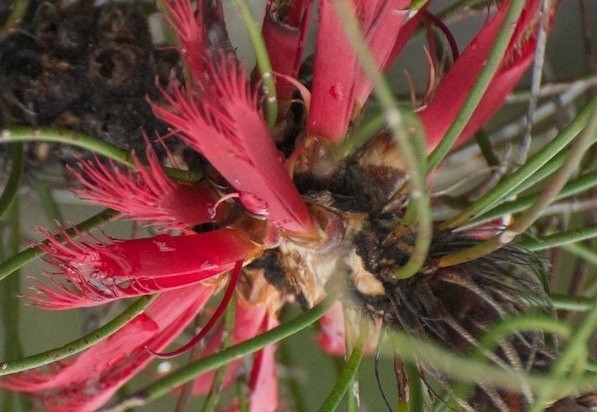Melaleuca longissima
(Melaleuca longissima)

Description
Calothamnus longissimus is a plant in the myrtle family, Myrtaceae and is endemic to the south-west of Western Australia. It is a small, spreading shrub with unusually long, fine leaves and which produces clusters of red flowers in spring. (In 2014 Craven, Edwards and Cowley proposed that the species be renamed Melaleuca longissima). Calothamnus longissimus is an erect, stiff, dense or spreading shrub growing to a height of about 1.5 metres (4.9 ft) with many branches and corky bark. Its leaves are fine but rigid, mostly circular in cross section, 150–300 millimetres (6–10 in) long and curved. The flowers are dark red and arranged in small spikes with the lower part of the flower embedded in the corky bark. The stamens are arranged in 4 claw-like bundles of unequal lengths - the upper two are longer and broader and the lower two lacking anthers. Flowering occurs in August to October and is followed by fruits which are woody capsules almost immersed in the corky bark. Calothamnus longissimus was first formally described by Victorian Government Botanist Ferdinand von Mueller in 1862 in the third volume (part 21) of Fragmenta Phytographiae Australiae. The specific epithet (longissimus) is a Latin word meaning "longest". Calothamnus longissimus is found in the Avon Wheatbelt, Geraldton Sandplains and Swan Coastal Plain biogeographic regions where it grows in kwongan. Calothamnus longissimus is classified as "not threatened" by the Western Australian government department of parks and wildlife. Calothamnus is a genus of shrubs in the family Myrtaceae and is endemic to the south-west of Western Australia. The common names one-sided bottlebrush or claw flower are given to some species due to their having the flowers clustered on one side of the stem or because of the claw-like appearance of their flowers. Calothamnus species are generally medium to tall woody shrubs with crowded leaves. In most species the leaves are crowded and linear in shape, and the flowers are usually arranged in dense clusters. The petals are small and fall off the flower soon after it opens but the stamens are long, numerous and usually bright red.
Taxonomic tree:







